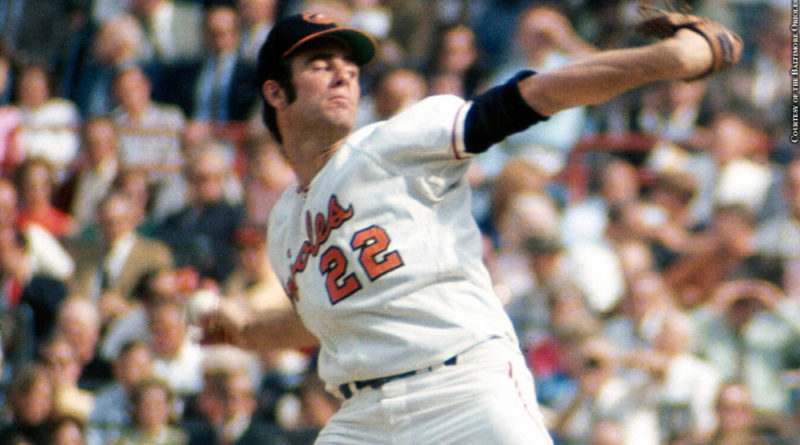On Aug. 13, 1969, Jim Palmer threw a no-hitter against the Oakland Athletics. Palmer joined Stan “The Fan” Charles and Ross Grimsley on Facebook Live Aug. 3 to discuss his memories of the no-hitter and some other moments throughout his career.
During his no-hitter in 1969, Palmer didn’t have Gold Glove winners Mark Belanger and Davey Johnson behind him at their normal positions. Instead, Bobby Floyd played shortstop and Don Buford played second base. Buford went 3-for-4 with two RBIs that night, while Floyd went 1-for-2.
“You have a no-hitter going — this is when you know Earl [Weaver] doesn’t really like you,” Palmer joked. “He’s got Belanger with eight Gold Gloves, Davey Johnson with three Gold Gloves sitting on the bench. Did they come in for defense? Absolutely not.”
Palmer also overcame allowing six walks, including three in the ninth inning. The first was to Reggie Jackson, one of many Hall of Fame opponents Palmer faced in his career. Palmer’s no hitter is even more impressive considering the circumstances. He threw 142 pitches in his second start after missing 52 days with a back injury.
Larry Haney grounded out to end the game. Haney later become a scout for the Montreal Expos and ran into Palmer in the press box at Camden Yards and shared a memory.
“He said my mother loved you. She said she was rooting more for you than me when you pitched the no-hitter,” Palmer said.
Palmer spent parts of 19 seasons as an Oriole from 1965-1984. The 1990 Baseball Hall of Fame inductee was a six-time All-Star, three-time Cy Young Award winner and won three World Series in Baltimore. He finished his career with a 2.86 ERA and struck out 2,212 hitters in nearly 4,000 innings. Arguably his best season was 1975, when he won the Cy Young Award with a 23-11 record, 2.09 ERA and 193 strikeouts in 323 innings.
Palmer started his pro career in Aberdeen, S.D., in the Northern League. He went 11-3 with a 2.51 ERA with the Pheasants in 1964, but he struggled with control and allowed 130 walks in 129 innings. After the season, he worked with former Orioles pitching coach George Bamberger every day for two months to cut down on the walks.
“I worked on my windup every day from the end of September all the way until November in the instructional league,” Palmer said. “George Bamberger taught me to throw the ball down and away to a right-handed batter because to do that you got to have perfect mechanics.”
Two years later in 1966, Palmer started Game 2 of the World Series against the Los Angeles Dodgers at Dodger Stadium as a 20-year-old. He pitched a shutout, only allowing four hits. He was the youngest player in World Series history to pitch a shutout.
Watching Game 1 from the dugout, Palmer noticed the Dodgers were struggling with hitting high fastballs and took advantage of it the next day. Palmer struck out six batters, and Baltimore went on to sweep Los Angeles in four games for its first championship in franchise history.
“To walk out of a ballpark when you’re about to turn 21 and be the world champs after winning four in a row is surreal,” Palmer said. “You want to pinch yourself and go did that really happen? It was over so quickly.”
A year later in 1967, Palmer was pitching in Triple-A Rochester on a rehab assignment. He was set to make his International League debut in Buffalo, but due to the 1967 Buffalo riots, the game was moved to a high school football field in Niagara Falls, N.Y. Palmer didn’t have a mound to warm up on and had to face Hall of Fame catcher Johnny Bench.
Bench played 17 seasons for the Cincinnati Reds from 1967-1983. He was inducted into the Hall of Fame in 1989 after playing in 14 All-Star games and winning 10 Gold Gloves. Bench led the Reds to back to back championships in 1975 and 1976, winning the World Series MVP in 1976.
Bench also hit the only grand slam Palmer ever gave up as a professional.
“I had a 6-0 lead and somehow Johnny swings at a fastball over his head and strikes out the first time,” Palmer said. “I walked the bases loaded in the fourth inning with a 6-0 lead and Earl Weaver goes nuts. He runs out to the mound — Bench is the next hitter — and says, ‘Throw the ball down the middle, let this guy hit the ball,’ and the last time we saw the ball it was heading toward Niagara Falls. So that’s the last time I ever listened to Earl.”
Palmer has been a color commentator for the Orioles since 1984. He had been the main color commentator for the Orioles on MASN until this season. Ben McDonald and Mike Bordick are the main color commentators this season with Palmer contributing on Zoom.
Palmer, who said Robin Roberts helped him develop as a pitcher, believes veterans Tommy Milone and Wade LeBlanc can do the same for fellow lefty John Means. Palmer views them as mentors for Means, an All-Star last season.
“I think we saw John Means with as good of a fastball as he ever had [his first two starts]. … He had as good of a curveball as I saw him have, the velocity doesn’t tell you the whole story,” Palmer said. “… He’s going to learn from LeBlanc and Tommy Milone.”
For more from Palmer, watch the full interview here:
Photo Credit: Courtesy of the Baltimore Orioles

